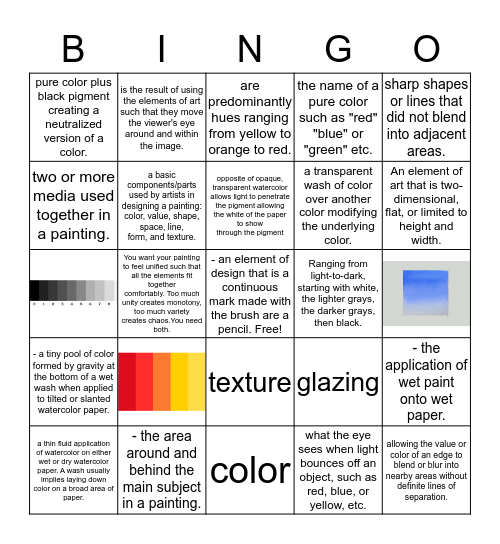

This bingo card has 5 images, a free space and 54 words: Hues next to each other on the color wheel, - the area around and behind the main subject in a painting., - a design principle that refers visually to the equalization of the elements in a painting. The three types are: symmetrical (formal), asymmetrical (informal), or radial (circular, radiating for a central point)., - a tiny pool of color formed by gravity at the bottom of a wet wash when applied to tilted or slanted watercolor paper., what the eye sees when light bounces off an object, such as red, blue, or yellow, etc., - are those colors directly opposite or across from each other on the color wheel, such as red and green or yellow and violet, a basic components/parts used by artists in designing a painting: color, value, shape, space, line, form, and texture., is an area of evenly distributed color. "Flat" meaning the color remains the same hue, value(or intensity) and textural quality. No brush strokes showing., a transparent wash of color over another color modifying the underlying color., - any gradual change in hue, value, or color intensity., the name of a pure color such as "red" "blue" or "green" etc., to take out or remove paint from an area of a watercolor painting., two or more media used together in a painting., the space in a painting that is not occupied by the subject matter that is still part of the overall designed of the painting., opposite of transparent, opaque watercolor reflects light rather than letting light pass through it., pure color plus black pigment creating a neutralized version of a color., allowing the value or color of an edge to blend or blur into nearby areas without definite lines of separation., sharp shapes or lines that did not blend into adjacent areas., pure color plus white pigment or with water added to dilute the color in transparent watercolor., opposite of opaque, transparent watercolor allows light to penetrate the pigment allowing the white of the paper to show through the pigment, Ranging from light-to-dark, starting with white, the lighter grays, the darker grays, then black., are predominantly hues ranging from yellow to orange to red., a thin fluid application of watercolor on either wet or dry watercolor paper. A wash usually implies laying down color on a broad area of paper., - the application of wet paint onto wet paper., a wash that gradually changes in value, - refers to free form shapes and free flowing lines. Opposite of geometrical., An element of art made up of three properties: hue, value, and intensity., An element of art that refers to the way things feel, or look as if they might feel if touched, An element of art that is two-dimensional, flat, or limited to height and width., An element of art that is three-dimensional and encloses volume; includes height, width AND depth (as in a cube, a sphere, a pyramid, or a cylinder). Form may also be free flowing., the lightness or darkness of tones or colors., the ratio of one art element to another. It is important to keep in mind the relationship between different elements of the composition so that the scale of your artwork always makes visual sense., When one element of an artwork stands out more than another., the counterweight to harmony and creates visual interest by slightly changing or using different elements together in a composition. It can be created with contrast, change, elaboration, or diversifying elements., is the result of using the elements of art such that they move the viewer's eye around and within the image., is the uniform repetition of any of the elements of art or any combination thereof., is created by movement implied through the repetition of elements of art in a non-uniform but organized way., You want your painting to feel unified such that all the elements fit together comfortably. Too much unity creates monotony, too much variety creates chaos.You need both., is the difference between elements of art in a composition, such that each element is made stronger in relation to the other. When placed next to each other, contrasting elements command the viewer's attention. Areas of contrast are among the fir, line, shape, form, value, texture, color, hue, tint, shade, bead, gradient, glazing, space, flat-wash and emphasis.
Watercolor/art | Art Bingo | Art Vocabulary | Art Vocabulary Paint/Color | Chapter 2 Bingo
Share this URL with your players:
For more control of your online game, create a clone of this card first.
Learn how to conduct a bingo game.
With players vying for a you'll have to call about __ items before someone wins. There's a __% chance that a lucky player would win after calling __ items.
Tip: If you want your game to last longer (on average), add more unique words/images to it.